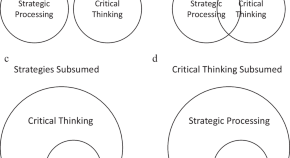Collection
Navigating the murky waters of higher order, critical, and critical analytic thinking
- Submission status
- Closed
This Special Issue brings together international scholars who are invested in documenting the growth and development of human thinking and reasoning but whose fields of inquiry, and thus their orientations on this important topic diverge. As contributors, we probed the depths of higher-order, critical, and critical-analytic thinking as these constructs have been described and investigated in theoretical and philosophical works, empirical research, and pedagogical practice. The ultimate aim of this exploration was to offer the educational research community, as well as practitioners, school leaders, and policymakers, a more detailed and integrated charting of the murky waters surrounding higher order, critical, and critical-analytic thinking that obscure the nature and association of these forms of prized human thought. Further, by juxtaposing these three forms, which are often undefined or ill-defined constructs in the literature and in everyday language, we charted both the similarities and differences of these valued modes of thinking in a manner that could guide empirical research, educational practice, and policymaking. Through this mapping expedition, we sought to provide others with a means to navigate the waters of higher order, critical, and critical analytic thinking more successfully.
Specific Contributions
To aid in this charting, contributing authors to this special issue carried out reviews of higher order, critical, and critical analytic thinking within specific realms of inquiry, and addressed the contextualization and manifestation of these constructs, as described in that body of work. These scholars also weighed the prevalence or general disregard of certain forms of prized thinking and overviewed the manner in which such thinking are unearthed and evaluated. The special issue opens with an overview by Lombardi that outlines a bit of the history of higher order, critical, and critical analytic thinking; discusses the rationale for this project; and briefly describes each of the articles that comprise the issue. The first of those articles is a thought-provoking and expansive look at each of the three forms through the lens of philosophy. Murphy et al. weave together a picture of what they collective entitled “value thinking” from writings of classic and contemporary philosophers. Moreover, they tackled the notion of valued thinking from the vantage point of power and privilege within society; in essence, who decides what thinking is prized and what is discounted?
In the ensuing article by Dinsmore and Fryer, the focus shifts to the role of cognitive and metacognitive strategies in understanding the boundaries between the three knowledge constructs. As Murphy et al. take on valued thinking from the perspective of power and privilege, Dinsmore and Frye challenge Cartesian efforts to classify strategies into discrete categories. Alternatively, these scholars illustrate how strategic engagement, as a whole, affords critical insights into the relations among higher order, critical, and critical analytic thinking. For their contribution to this special issue, List and Sun draw on the expanding literature dealing with the use of multiple sources in completion of demanding cognitive tasks. Their unique approach described and classified the array of cognitive and self-regulatory processes that have been unearthed and assessed within multiple source research by using designations associated with Bloom et al.’s (1956) initial taxonomy of educational objectives for the cognitive domain as the framing mechanism. By comparison, Loyens et al. turn to the work aligned with student-centered approaches to learning and instruction. Specifically, these scholars focused primarily on studies of problem-based and project-based learning that populate the literature. These authors rely principally on the Delphi Report on critical thinking authored by Facione and colleagues (1990) as their guide for this review to determine how prized forms of thinking and reasoning are conceptualized and enacted within student-centered classrooms.
Based on this excellent assemblage of reviews and the new vistas and insights each provided, Alexander closes the special issue by offering a new mapping of the realm of human thought that has variably been designated as “higher order,” “critical,” and “critical analytic.” In this synthesis of the rich explorations conducted by the contributing authors, she chart the boundaries that seemingly exist between each of these forms that have long been treasured aims of quality learning and instruction.
Editors
-
Patricia A. Alexander
Patricia A. Alexander is a Distinguished University Professor, the Jean Mullan Professor of Literacy, and Distinguished Scholar-Teacher in the Department of Human Development and Quantitative Methodology at the University of Maryland. She has published over 330 articles, books, chapters, and monographs and made over 400 presentations on the topics learning, academic development, and literacy. She served as the Senior Editor of Contemporary Educational Psychology for over two decades and is currently on 12 editorial boards including the senior advisory board for Educational Psychology Review.
-
Doug Lombardi
Doug Lombardi is an Associate Professor, Department of Human Development and Quantitative Methodology, at the University of Maryland. As the head of the Science Learning Research Group (http://sciencelearning.net), he conducts research examining reasoning and critical thinking about knowledge claims. Much of this research is situated within the context of formal classroom settings and focuses on effective teaching tools and strategies to support deep learning, particularly about scientific topics that pose local, regional, and global challenges (e.g., causes of current climate change, availability of freshwater resources).
Articles (6 in this collection)
-
-
To Clarity and Beyond: Situating Higher-Order, Critical, and Critical-Analytic Thinking in the Literature on Learning from Multiple Texts
Authors
- Alexandra List
- Yuting Sun
- Content type: REVIEW ARTICLE
- Published: 24 March 2023
- Article: 40

-
Situating Higher-Order, Critical, and Critical-Analytic Thinking in Problem- and Project-Based Learning Environments: A Systematic Review
Authors (first, second and last of 4)
- Sofie M. M. Loyens
- Julianne E. van Meerten
- Lisette Wijnia
- Content type: REVIEW ARTICLE
- Open Access
- Published: 21 March 2023
- Article: 39

-
On the Horizon: the Promise and Power of Higher Order, Critical, and Critical Analytical Thinking
Authors
- Doug Lombardi
- Content type: Review Article
- Published: 20 March 2023
- Article: 38
-
Critical Thinking and Its Relation to Strategic Processing
Authors
- Daniel L. Dinsmore
- Luke K. Fryer
- Content type: REVIEW ARTICLE
- Published: 14 March 2023
- Article: 36

-
“Valued” Thinking in Education: Liberating the Narrative
Authors
- P. Karen Murphy
- Tyler M. Ogata
- Eric C. Schoute
- Content type: Review Article
- Published: 14 March 2023
- Article: 35



